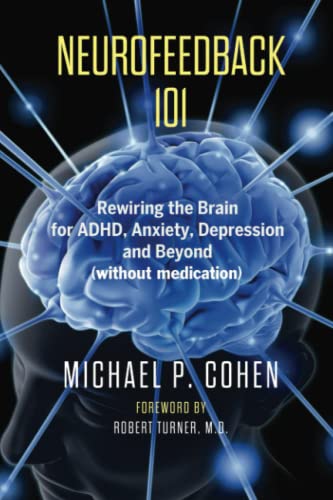 Neurofeedback 101: Rewiring the Brain for ADHD, Anxiety, Depression and Beyond (without medication)
Neurofeedback 101: Rewiring the Brain for ADHD, Anxiety, Depression and Beyond (without medication)
By Michael P. Cohen
You really CAN change your brain without medication.
Maybe you’ve struggled for years with anxiety, depression, ADHD, migraines, PTSD, obsessive thinking, sleep issues or other unwanted conditions. You’ve tried medication, psychotherapy, breathing techniques, yoga, exercise or dietary changes—with no permanent relief.
Neurofeedback is an emerging technology that’s helped thousands of people feel better—without medication. It allows you to gently nudge your brain along through training until it learns to operate in a healthier manner.
Neurofeedback is a form of biofeedback that’s like a gym for your brain. The training improves your brain’s timing which, in turn, improves its functioning. When your brain works better, you feel better. It’s like heavy-duty weight training for the brain, even though you do it while relaxing in a chair.
Once you’ve done sufficient training, these improvements are often long-term.
Neurofeedback 101 explains how you change your brain–in clear, simple terms. It’s full of real cases of how training has helped children and adults with their symptoms. There’s a section that offers a thorough discussion of important questions and issues about neurofeedback – designed both for professionals and consumers.
Author Michael P. Cohen is Director and Chief of Neurotechnology at the Center for Brain Training in Jupiter, Florida, one of the largest neurofeedback practices in South Florida. He’s specialized in neurofeedback and helping individuals improve their brain function since 1996. He’s taught more than 2,500 health professionals how to utilize neurofeedback in a clinical practice.
If you want to explore how the brain can rewire and retrain itself, Neurofeedback 101 will give you the answers and resources you need.
Please note: This book is NOT a manual or textbook on how to conduct neurofeedback. It provides general information on what neurofeedback is, how it works, and what neurofeedback can do. Those wishing to learn how to do neurofeedback should seek out books designed for that purpose.
Review
Neurofeedback 101 is an excellent overview of how neurofeedback works, and its impact. It’s an easy read–not too complicated nor oversimplified. I found the FAQ section superb, and the case histories corroborated over and over the experiences I’ve witnessed with my own patients.
Those of us who know what neurofeedback can do want as many people as possible to learn about it. This book is the perfect tool to achieve that end.
I frequently ask myself why, if neurofeedback has been around for decades and has an evidence-based foundation, isn’t it more mainstream. Why is it not being offered more broadly around the world? Mike tackles that question, and many more, in this book.
Neurofeedback is an amazing healthcare intervention, and Neurofeedback 101 is a valuable overview for anyone who has a personal or professional interest in it.
–Robert P. “Rusty” Turner M.D.
Founder, Network Neurology and Network Neurology Health, LLC
Charleston, South Carolina
Neurofeedback 101 is very readable, whether you’re a physician or a layperson interested in learning about neurofeedback.There’s a lot of knowledge packed into this book, but it’s not so technical or in-depth that lay readers will get lost in it. The way the book is organized, patients can easily find the parts that pertain to them and better understand the process. It will arm them with enough knowledge to decide more confidently whether or not to move forward with training.
For providers of neurofeedback, having patients read the book means they’ll be able to spend less time explaining it and more time working on the patient’s personalized approach. It will also be handy for people in clinical practice considering offering neurofeedback.
Even if physicians and mental health providers aren’t interested in offering neurofeedback themselves, this book will give them enough basic knowledge to be comfortable recommending it, and explaining it, to their patients.
–Kimberly Hogan Pesaniello, M.D.
Psychiatrist
Snow Hill, Maryland
This book is written in such a way that people who don’t know anything about neurofeedback will get it. The author writes in an engaging manner, using language people can understand. The chapter on case examples demonstrates the power of neurofeedback by showing actual examples of how neurofeedback has impacted people’s lives.
I’m going to suggest to potential neurofeedback clients that they read this book to help them decide whether to go forward with training or not. I’m going to ask my current neurofeedback clients to read it because the more they understand, the better their neurofeedback training will work. And I’m going to ask all the neurofeedback practitioners I mentor to read it, too. There’s a lot of good information in the book for both the general public and the professionals.
–Glenn Weiner, Ph.D.
Licensed Clinical Psychologist




Leave a Reply